Journal of Microwave Chemistry
Vol.
04
No.
03
(
2020
), Article ID:
40337
,
14
pages
10.12677/MC.2020.43003
微波在环氧树脂体系中的应用研究进展
胡红兵1,2*,樊庆春3,胡文祥1,3,4,5#
1武汉工程大学化学与环境工程学院,湖北 武汉
2广州市金永固新材料有限公司,广东 广州
3武汉工程大学化工与制药学院,湖北 武汉
4北京神剑天军医学科学院京东祥鹄微波化学联合实验室,北京
5中国人民解放军战略支援部队航天系统部,北京

收稿日期:2021年1月7日;录用日期:2021年1月29日;发布日期:2021年2月9日

摘要
本文综述了近年来微波在环氧树脂体系中的研究进展。利用微波来促进环氧树脂体系的最新应用,包括环氧树脂合成、环氧树脂体系辅料(增塑剂等)的合成,环氧树脂固化剂的合成,环氧树脂体系填料的活化,重点是环氧树脂固化过程中的微波应用,还涉及到热固性环氧树脂固化物的微波降解改性。
关键词
环氧树脂,微波,合成,固化,降解
Progress in Epoxy Resin System with Microwave
Hongbing Hu1,2*, Qingchun Fan3, Wenxiang Hu1,3,4,5#
1School of Chemistry and Environmental Engineering, Wuhan Institute of Technology, Wuhan Hubei
2Canton Kingyork New Materials Company, Guangzhou Guangdong
3School of Chemical Engineering and Pharmacy, Wuhan Institute of Technology, Wuhan Hubei
4Jingdong Xianghu Microwave Chemistry Union Laboratory, Beijing Shenjian Tianjun Academy of Medical Sciences, Beijing
5Aerospace Systems Division, Strategic Support Troops, Chinese People’s Liberation Army, Beijing

Received: Jan. 7th, 2021; accepted: Jan. 29th, 2021; published: Feb. 9th, 2021

ABSTRACT
The research progress in epoxy resin system with microwave in recent years was reviewed. Microwave is used to promote the latest application of epoxy resin system, including the synthesis of epoxy resin, the synthesis of auxiliary materials (plasticizers, etc.) of epoxy resin system, the synthesis of epoxy resin curing agent, microwave activation of fillers and the microwave application in the curing process of epoxy resin, as well as the microwave degradation modification of thermosetting epoxy resin.
Keywords:Epoxy Resin, Microwave, Synthesis, Consolidation, Degradation

Copyright © 2020 by author(s) and Hans Publishers Inc.
This work is licensed under the Creative Commons Attribution International License (CC BY 4.0).
http://creativecommons.org/licenses/by/4.0/


1. 引言
随着社会的发展和科技的进步,材料科学是当今最热门的研究领域之一,航天材料、各类耐高温高压等特殊性能材料、纳米材料、二维材料、芯片材料及超材料等愈来愈引起人们的高度关注!许多经典材料,例如环氧树脂等经过改性后,在许多领域包括芯片制造等高新技术领域发挥重要作用。
微波因具有作用深度大、操作简便、清洁、高效、安全等许多优点,广泛应用于许多领域,包括高分子材料领域:橡胶硫化、复合材料成型、环氧树脂固化等。环氧树脂综合性能良好,在复合材料、胶粘剂和涂料等领域应用广泛,其固化技术一直是重要的研究领域 [1],把微波应用于环氧树脂的固化是一种新的尝试 [2]。目前,关于微波辐射对环氧树脂固化的作用机理还存有一些争议 [3],一种观点认为微波辐射只有热效应;另一种观点认为除了具有热效应外,微波辐射还有非热效应 [4] - [8]。对这些机理的进一步研究,不但有助于促进微波在环氧树脂固化领域的应用,而且对环氧树脂性能的提高也有重要的指导意义。
2. 环氧树脂体系的合成
2.1. 新型环氧树脂的合成
微波反应可应用于新型环氧树脂单体合成,或者新型环氧树脂合成。
丁全青以芴酮和苯酚为原料,合成了双酚芴(BHPF)单体,并以此为原料合成了芴基环氧树脂 [9]。

Figure 1. Synthesis of BHPF
图1. 双酚芴合成
参考图1,在同等条件下,常规加热合成方法60℃需要5 h,而微波合成方法55℃只需要30 min [9]。
武文硕研究了玉米秸秆合成新的生物基环氧树脂。微波加热温度在160℃左右,加热时间控制在22 min左右,苯酚液化秸秆;微波加热温度85℃,时间在60 min,合成生物质环氧树脂 [10]。
2.2. 环氧树脂固化剂的合成
Moraa等以腰果农副产品腰果酚为原料,用微波在110℃~120℃,促进胺化反应1.5~2 h,设计合成了含芳香族基团的新型生物胺类化合物 [11],参考图2:
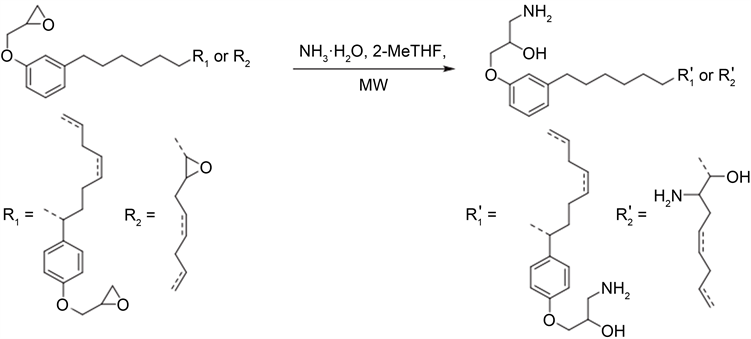
Figure 2. Aminations of NC-514 (R1) and GX-2551 (R2)
图2. NC-514 (R1)和GX-2551 (R2)的胺化
张翠红等以甲醛、多胺(四乙烯五胺或二乙烯三胺)、硫脲、苯酚为原料,微波条件下110℃ × 40 min合成低温固化剂,固化剂可在−10℃以下温度完全固化环氧树脂 [12]。而常规加热方式110℃合成低温固化剂需要3 h [13]。
2.3. 环氧树脂添加剂的合成
蓖麻油酸乙二醇醚酯可以作为环氧树脂的增塑剂。朱新宝等开发了一种改进的微波辅助技术,直接从蓖麻油酸制备蓖麻油酸乙二醇醚酯。蓖麻油酸(10.0 mmol)和乙二醇醚(12.0 mmol)在NaHSO4·H2O (0.01% mol)和DCM (3.0 ml)存在下,在微波作用下150℃ × 25 min反应,得到了产物蓖麻油酸乙二醇醚酯 [14]。
3. 填料的微波活化
天然纤维增强聚合物复合材料在工业上,特别是在汽车工业上有着广泛的应用。然而,低的机械性能和热性能限制了其应用。芭蕉(Musa paradisiaca)采自尼日利亚西南部,Patrick EhiImoisili等采用水脱胶法从假茎中提取纤维。提取的纤维首先用3%氢氧化钠溶液处理4小时。采用三洋电子em51052微波炉对芭蕉纤维进行微波辐射处理,微波辐射功率550 W,频率2.45 GHz,处理时间2 min。SEM分析表明,微波处理后纤维表面粗糙度均匀,杂化纤维与聚合物基体具有良好的机械互锁性。这一结果表明,多壁CNT杂化可以提高芭蕉纤维增强聚合物复合材料的力学性能和热性能,具有潜在的工业应用前景 [15]。
在羧基多壁CNT分散于环氧树脂作为母料的过程中,用微波处理的可以长期保持均一相,而未经微波处理的在20天后,清楚的看到沉淀物。微波处理后可以抑制大尺寸聚集体的形成,有效改善羧基多壁CNT的分散 [16]。
很多学者对于填料进行微波处理,以应用于环氧树脂中,例如CNT [17] [18]、多壁CNT [19]、木质素 [20]、石墨烯 [21]、碳纤维 [22]、TiO2 [23]、赭石 [24] 等,都取得了比较满意的效果。
4. 环氧树脂的固化
4.1. 无填料环氧树脂体系
蔡晓霞发现微波辐射条件下环氧树脂与固化剂反应时的反应速度高于在传统条件下环氧树脂与固化剂反应时的反应速度。
E-51/100A在100℃,E-51/DDS在150℃,E-51/DDM在80℃,E-44/DICY在165℃固化度达到0.5时,在微波辐射条件下反应所需时间分别是在传统条件下反应所需时间的30%、12.5%和25%。
E-44/100A在100℃条件下,E-44/DDS在150℃条件下反应,E-44/DDM在110℃条件,E-44/DICY在165℃条件下,固化度达到0.7时,在微波辐射条件下反应所需时间分别是在传统条件下反应所需时间的23%、25%、40%和25% [25]。
很多学者也做了有力的探索 [26] - [31]。
4.2. 有填料环氧树脂体系
Ranu Pala等以膨胀石墨(EG)为填料,经微波(800 W × 20秒)固化,以提高环氧树脂复合材料的介电性能,与纯环氧树脂相比,微波固化3 wt% EG/环氧树脂复合材料的玻璃化转变温度和储能模量分别提高约24℃和58% [32]。参考表1,这里微波固化的Tg反低于常规加温固化的Tg,这点值得大家思考。
Table 1. Glass transition temperatures of pure epoxy and different loadings of EGs in epoxy cured by MW and CV
表1. 纯环氧及环氧中不同添加量的膨胀石墨在微波和常规加热固化的玻璃化转变温度
4.3. 环氧树脂体系后固化
Huiyuan Deng等用微波辅助热固化技术控制相分离的聚醚砜增韧环氧树脂。见表2,可以看到凝胶时间和后固化时间大大缩短 [33]。
很多学者对于Al2O3 [34]、玻纤增强 [35] [36]、环氧砂浆 [37] [38]、纳米银 [39]、石墨 [40] [41]、石墨烯 [42]、SiC [43]、SiO2 [44]、碳纤增强 [45] - [53]、土工支架 [54] 及其他复合材料 [55] - [60] 等环氧树脂体系进行了微波固化研究。
采用微波固化法制备的水含量高达10%和10%~15%的水溶性环氧砂浆,与混凝土的相容性较好 [61]。
微波能提高环氧砂浆的强度和粘结性能,促进混凝土的有效修补。与露天养护(后固化)相比,微波养护(后固化)可有效降低环氧砂浆的热膨胀系数(CTE),水溶性树脂水含量达到10%时,CTE平均降低约36%;水溶性树脂水含量超过10%时,CTE平均降低约23% [61]。
Table 2. Phase Separation Time and Gelation Time for PES/EP prepolymers
表2. PES/环氧预聚物的相分离时间和凝胶化时间
4.4. 环氧树脂固化物的降解与回收
虽然可以将废弃的环氧树脂固化物粉碎后,代替矿物填料 [62],但是这样并不能使经济最大化。
Xu Zhao等将废弃的环氧树脂固化物,回收制成有机胺固化剂 [63]。
降解环氧树脂固化物,常规的催化剂ZnCl2/水、ZnCl2/乙醇、AlCl3/乙酸、磷钨酸等,一般的温度要高于200℃。参考图3、方案1和方案2,Xu Zhao等用二乙烯三胺(DETA)微波辅助催化降解环氧/甲基四氢苯酐固化物(MER),130℃ × 50 min达到99%的降解效率 [63]。
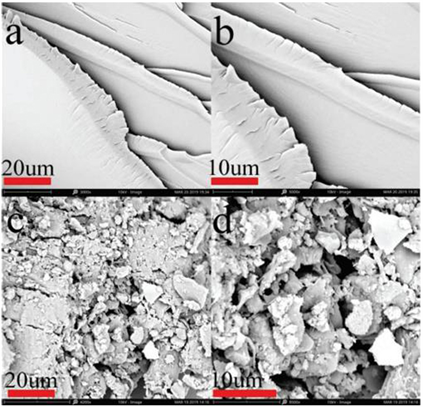
Figure 3. SEM analysis of MER (a, b) and DCM-MER (c, d)
图3. MER(a, b)和二氯甲烷-MER(c, d)的SEM分析

Scheme 1. The decomposition process of MER
方案1. MER的分解过程
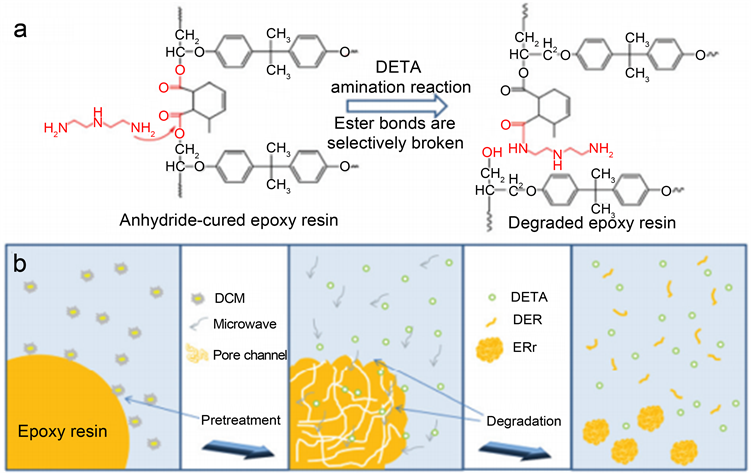
Scheme 2. (a) Chemical structure and amination process of MER; (b) diagram of MER pretreatment with DCM and microwave-assisted amination process by DETA
方案2. (a) MER的化学结构和胺化过程;(b)二氯甲烷预处理MER和DETA微波辅助胺化过程示意图
参考图4,Jianying Deng等对废弃的环氧树脂CFRP复合材料微波处理,回收碳纤维 [64]。
从图5和图6可以看出,450℃温度下,13 min微波处理得到的碳纤维,远远好于常规加热方式得到的碳纤维。
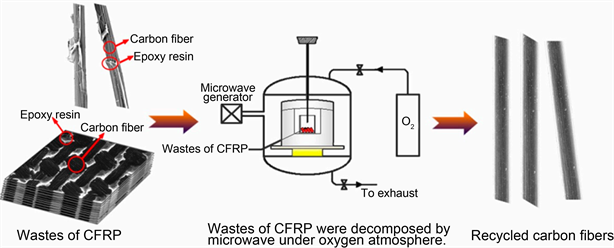
Figure 4. Schematic of carbon fiber-reinforced polymer (CFRP) waste treatment by microwave thermolysis
图4. 碳纤维增强聚合物(CFRP)废物微波热分解处理示意图

Figure 5. The macroscopic appearances of the CFRP waste samples after experiments: (a) 30 min of traditional heating at 400˚C; (b) 30 min of traditional heating at 450˚C; (c) 30 min of traditional heating at 500˚C; (d) 13 min of microwave heating at 450˚C
图5. 试验后碳纤维增强复合材料废料样品的宏观形貌:(a) 400℃传统加热30分钟;(b) 450℃传统加热30分钟;(c) 500℃传统加热30分钟;(d) 450℃微波加热13分钟
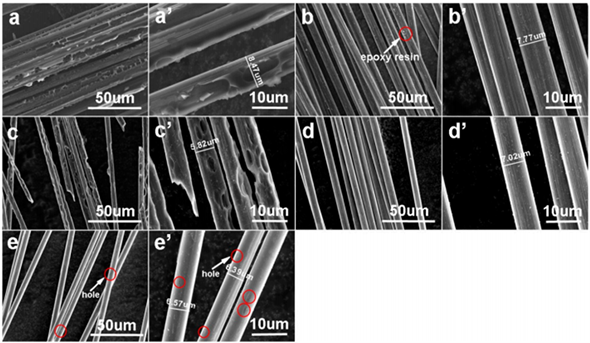
Figure 6. Field emission scanning electron microscope (FESEM) images of recovered carbon fibers: (a) and (a’) 30 min of traditional heating at 400˚C; (b) and (b’) 30 min of traditional heating at 450˚C; (c) and (c’) 30 min of traditional heating at 500˚C; (d) and (d’) 13 min of microwave heating at 450˚C; (e) and (e’) 30 min of microwave heating at 450˚C
图6. 回收碳纤维的场发射扫描电子显微镜(FESEM)图像:(a)和(a’) 400℃传统加热30分钟;(b)和(b’) 450℃传统加热30 min;(c)和(c’) 500℃传统加热30 min;(d)和(d’) 450℃微波加热13 min;(e)以及(e’) 在450℃下微波加热30 min
Yuichi Tominaga等利用回收的碳纤维,做了环氧树脂微波固化测试 [65]。
Tian Fei等通过微波辅助溶胀对废环氧树脂固化物进行物理改性,可以制备出均匀互穿的纳米孔,通过改变溶胀溶剂的极性,制备了高性能油水分离材料,可以简单地调节孔径以满足各种油水混合物有效分离的要求 [66]。
4.5. 微波固化理论与工艺
Yingguang Li等报道,与传统的热固化方法相比,间接微波固化周期和能耗分别降低了42.1%和75.9%。进一步的表征实验结果表明,间接微波固化试样的力学性能略高于热固化试样 [67]。
Robert L. Hubbard根据环氧树脂的各种结构特点,比较了普通环氧树脂与二胺交联剂在均匀微波场中的反应速率。采用统计设计的实验矩阵确定固化速率仅与两个显著变量(胺碱度和反应物的转动自由度(熵))线性相关。分子偶极率,被公认为是微波电磁能转移到具有永久偶极子的分子的原因,但这次实验结果出乎预料。实验结果显示,分子偶极率即使是作为一个因变量,也没有显著效果。Robert L. Hubbard提出了一个非常高的概率模型,精确地预测了环氧化物和二胺反应物相对于特定结构特征的反应性。作为进一步的证据提供了一个主导的线性预凝胶聚合和均匀的微波反应场 [68]。
张翔等对环氧树脂复合材料微波固化过程进行了数值模拟 [69]。
Table 3. Curing degree and difference between outer surface point A and inner surface D of NOL ring at different times (heat curing mode)
表3. 不同时刻NOL环外表面点A和内表面D的固化度及其差值(热固化方式)
Table 4. Curing degree and difference between outer surface point A and inner surface D of NOL ring at different times (microwave curing mode)
表4. 不同时刻NOL环外表面点A和内表面D的固化度及其差值(微波固化方式)
如上表3和表4,张翔在微波固化过程中,复合材料NOL环沿厚度方向的固化度呈现一定的梯度分布特征,表现出由外表面向内表面逐渐增大的趋势,较传统热固化方式显著降低了复合材料NOL环内部的固化度分布梯度,有效改善了固化均匀性 [69]。
4.6. 微波固化设备
里耶斯·豆阿吉、雷运波等分别申请了微波方面的专利 [70] [71]。He开发了在线监测微波环氧树脂固化 [72]。
图7是我国微波化学仪器的开拓者——北京祥鹄科技发展有限公司,为北京化工大学定制的XH-200C型全能型微波固化反应器,满足了用户的实验要求 [16]。

Figure 7. XH-200COmnipotent microwave Omnipotent microwave consolidation reactor
图7. XH-200C型全能型微波固化反应器
4.7. 微波敏感剂
陈名华等发现分散在胶中的Fe3O4粉体能吸收大量微波,缩短固化时间,其含量为10份时性能最佳 [3]。
5. 展望
2016年有专家就环氧树脂及其复合材料微波固化研究进展作了综述 [73],并且提出了一些问题:
1) 为了调整有效的微波固化工艺,需要全面了解热固性树脂的介电性能,以及碳纤维增强热固性复合材料中所含增强材料的介电效应(例如,屏蔽和微波穿透深度),因此,需要高度可调的过程控制参数,使微波处理能够广泛的组合聚合物增强类型。
2) 在文献中,微波固化被认为是最具时间和能量效率的工艺,尽管综述中描述了所有挑战,这些挑战将微波固化工艺的成功与挑战和图8中总结的一些参数在原位处理之前和现场的考虑高度相关(图8摘自 [74],原图公式错误,本文作者已经修正)。对于相对较厚的材料,应特别考虑微波的体积加热特点,微波穿透深度取决于微波频率和腔体。
3) 热固性树脂的介电性能受增强材料的性质和类型、样品制备方法、温度和固化程度的影响,固化程度将影响环氧树脂的微波吸收,从而影响其加热的耗散程度,需要工艺参数控制的微波炉,以避免不均匀固化。
4) 在设计与FRP复合材料的几何特性有关的有效固化循环时,必须考虑微波加工用腔体的体积和尺寸。由于微波炉制造完成后腔体的尺寸是固定的,所以可以将重点放在其他参数的调整上,然而,设计师可能会追求可变腔体微波的新设计,以有效的固化不同的几何形状/尺寸。
5) 微波反应器腔内功率分布的不均匀,会导致样品和/或受热点的不均匀加热。这与上述第3项有关热固性聚合物的电介质参数的影响有关。
6) 最后,在微波固化的常规加热中使用的推荐固化周期的错误实施也是通过微波加热,最终微波复合材料产品劣化和结构件机械性能差的原因 [74]。
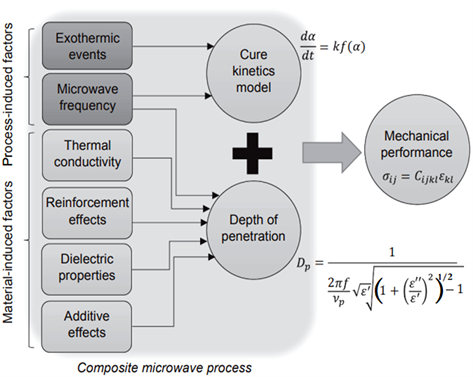
Figure 8. Major factors affecting efficiency and reliability of FRP composites microwave process
图8. 影响FRP复合材料微波加工效率和可靠性的主要因素
今后,需要加强下列三个方面的研究工作:
1) 微波与其他手段的联用 [2]。Ying Wu等提出一种用于环氧树脂固化之新型间隙同轴微波复合紫外线辐射器。使用该辐射器处理时间比单次紫外光处理时间短3.6倍 [75]。
2) 其它热固性树脂固化前,可以用微波辅助加热 [76],一样可以用于环氧树脂。
3) 工业上应用的管式微波反应器、开放式微波发生器研发尚待进一步加强。
早在1985年,胡文祥在中国科学院上海有机化学研究所创立了有机微波化学 [77] [78],迄今已36年过去了,微波化学得到了长足发展 [79] - [91]。微波在纳米材料 [8] 和常规新材料等领城之应用研究如火如荼,其发展一日千里。
文章引用
胡红兵,樊庆春,胡文祥. 微波在环氧树脂体系中的应用研究进展
Progress in Epoxy Resin System with Microwave[J]. 微波化学, 2020, 04(03): 23-36. https://doi.org/10.12677/MC.2020.43003
参考文献
- 1. 吴雪贞. 环氧树脂固化工艺及其固化剂研究[J]. 中国石油和化工标准与质量, 2017, 37(7): 127-128.
- 2. 胡曌玺, 喻长远, 陈禹保, 等. 交叉科学研究进展——胡文祥交叉科学相关研究部分论文[M]. 武汉: 汉斯出版社, 2020.
- 3. 陈名华, 姚武文, 王新坤, 等. 微波固化碳纤维/环氧树脂胶的研究[J]. 粘接, 2005, 26(6): 13-15.
- 4. 郝静远, 王存文, 胡文祥. 书评: 《微波化学》[J]. 微波化学, 2019, 3(2): 15-27.
- 5. 金钦汉, 戴树珊, 黄卡玛. 微波化学[M]. 北京: 科学出版社, 1999.
- 6. 张寒琦, 金钦汉. 微波化学[J]. 大学化学, 2001, 16(2): 32-36.
- 7. 秦宁, 闵清, 阮新志, 等. 书评: 《微波化学研究进展——京东祥鹄微波化学联合实验室微波化学领域相关研究成果目录及部分论文集》[J]. 微波化学, 2019, 3(3): 29-35.
- 8. 胡曌玺, 王存文, 闵清, 等. 微波化学研究进展——京东祥鹄微波化学联合实验室微波化学领域相关研究成果目录及部分论文集[M]. 武汉: 汉斯出版社, 2019.
- 9. 丁全青. 芴基环氧树脂的固化机制及性能研究[D]: [硕士学位论文]. 哈尔滨: 哈尔滨工程大学, 2011.
- 10. 武文硕. 微波液化玉米秸秆及环氧树脂的制备与性能研究[D]: [硕士学位论文]. 保定: 河北大学, 2015.
- 11. Moraa, A.-S., Tayouob, R., Boutevina, B., et al. (2019) Synthesis of Biobased Reactive Hydroxyl Amines by Amination Reaction of Cardanol-Based Epoxy Monomers. European Polymer Journal, 118, 429-436. ://doi.org/10.1016/j.eurpolymj.2019.06.020
- 12. 张翠红, 陈志敏, 李松栋, 等. 微波法合成环氧树脂低温固化剂及其性能研究[J]. 热固性树脂,2020, 35(1): 7-11.
- 13. 张翠红, 陈志敏, 李松栋. 环氧树脂低温固化剂的制备及性能研究[J]. 热固性树脂, 2016, 31(4): 25-27, 36.
- 14. Zhang, H.F., Zhu, F.F., Xu, Y., et al. (2017) Microwave-Assisted NaHSO4-Catalyzed Synthesis of Ricinoleic Glycol Ether Esters. Synthetic Communications, 47, 486-495. ://doi.org/10.1080/00397911.2016.1268695
- 15. EhiImoisili, P., Ukoba, K. and Jen, T.-C. (2020) Physical, Mechanical and Thermal Properties of High Frequency Microwave Treated Plantain (Musa paradisiaca) Fibre/MWCNT Hybrid Epoxy Nanocomposites. Journal of Materials Research and Technology, 9, 4933-4939. ://doi.org/10.1016/j.jmrt.2020.03.012
- 16. Liu, X., Luo, J.T., Fan, J.F., et al. (2019) Comprehensive Enhancement in Overall Properties of MWCNTs-COOH/Epoxy Composites by Microwave: An Efficient Approach to Strengthen Interfacial Bonding via Localized Superheating Effect. Composites Part B: Engineering, 174, Article ID: 106909. ://doi.org/10.1016/j.compositesb.2019.106909
- 17. Zhang, C., Liu, L.S., Xu, Z.W., et al. (2018) Improvement for Interface Adhesion of Epoxy/Carbon Fibers Endowed with Carbon Nanotubes via Microwave Plasma-Enhanced Chemical Vapor Deposition. Polymer Composites, 39, E1262-E1268. ://doi.org/10.1002/pc.24843
- 18. Moaseri, E., Behnaz, B., Majid, K., et al. (2019) Mechanical Improvements of Multi-Walled Carbon Nanotube-Epoxy Composite: Covalent Functionalization of Multi-Walled Carbon Nanotube by Epoxy Chains. Polymer Science, Series B, 61, 341-348. ://doi.org/10.1134/S1560090419030072
- 19. OdomMorgan, G.B., Sweeney, C.B., et al. (2017) Rapid Curing and Additive Manufacturing of Thermoset Systems Using Scanning Microwave Heating of Carbon Nanotube/Epoxy Composites. Carbon, 120, 447-453. ://doi.org/10.1016/j.carbon.2017.05.063
- 20. Marciano, S.J., Avelino, F., da Silv, L.R.R., et al. (2020) Microwave-Assisted Phosphorylation of Organosolv Lignin: New Bio-Additives for Improvement of Epoxy Resins Performance. Biomass Conversion and Biorefinery. ://doi.org/10.1007/s13399-020-01048-7
- 21. Carlo, B., Martina, R., Renato, B., et al. (2020) Investigation of Plasma-Assisted Functionalization of Graphitic Materials for Epoxy Composites. Nanomaterials, 10, 78. ://doi.org/10.3390/nano10010078
- 22. Yuan, J.-M., Fan, Z.-F., Yang, Q.-C., et al. (2018) Surface Modification of Carbon Fibers by Microwave Etching for Epoxy Resin Composite. Composites Science and Technology, 164, 222-228. ://doi.org/10.1016/j.compscitech.2018.05.043
- 23. Khaledeh, M., Aziz, A., et al. (2020) Amine-Functionalized TiO2 Nanoparticles Covalently Loaded into Epoxy Networks via Thermal and Microwave Curing Processes. Macromolecular Research, 28, 567-572. ://doi.org/10.1007/s13233-020-8067-3
- 24. Bekeshev, A., Mostovoy, A., et al. (2020) Reinforcement of Epoxy Composites with Application of Finely-Ground Ochre and Electrophysical Method of the Composition Modification. Polymers, 12, 1437. ://doi.org/10.3390/polym12071437
- 25. 蔡晓霞. 微波作用下双酚A型环氧树脂固化行为的研究[D]: [硕士学位论文]. 北京: 北京化工大学, 2004.
- 26. Sébastien, G., Philippe, T. and Maëlenn, A. (2018) Fast Polymerization at Low Temperature of an Infrared Radiation Cured Epoxy-Amine Adhesive. Thermochimica Acta, 666, 27-35. ://doi.org/10.1016/j.tca.2018.05.018
- 27. 孙涛, 常新龙, 赖建伟, 等. 不同固化方式下环氧树脂体系固化行为及力学性能研究[J]. 固体火箭技术, 2012, 35(5): 679-682+687.
- 28. 谷晓昱, 张军营. 微波固化环氧树脂中非热效应的研究[J]. 高分子材料科学与工程, 2006, 22(3): 183-186.
- 29. 张远方, 刘学清, 刘继延. 微波固化环氧树脂/氨基二苯醚树脂的耐热性能研究[J]. 中国塑料, 2015, 19(1): 18-21.
- 30. 耿杰, 李勇, 陈云雷, 等. 环氧树脂聚酰胺体系微波固化特性研究[J]. 玻璃钢/复合材料, 2013(5): 7-13.
- 31. 孙晓峰, 马世宁, 朱乃姝, 等. 环氧树脂胶粘剂微波固化研究[J]. 中国工程机械学报, 2010, 8(1): 107-110.
- 32. Pala, R., Akhtara, M.J. and Kara, K.K. (2018) Study on Dielectric Properties of Synthesized Exfoliated Graphite Reinforced Epoxy Composites for Microwave Processing. Polymer Testing, 70, 8-17. ://doi.org/10.1016/j.polymertesting.2018.06.011
- 33. Deng, H.Y., Yuan, L., Gu, A.J., et al. (2020) Facile Strategy and Mechanism of Greatly Toughening Epoxy Resin Using Polyethersulfone through Controlling Phase Separation with Microwave-Assisted Thermal Curing Technique. Journal of Applied Polymer Science, 137, 48394. ://doi.org/10.1002/app.48394
- 34. 郑伟峰, 周来水, 袁铁军, 等. 颗粒Al2O3增强环氧树脂复合材料的微波固化动力学及性能[J]. 高分子材料科学与工程, 2017, 33(10): 65-71.
- 35. Bhudolia, S.K., Gohel, G., Joshi, S.C., et al. (2020) Vibration Damping and Dynamic Mechanical Attributes of Core-Shell Particles Modified Glass Epoxy Prepregs Cured Using Microwave Irradiations. Composites Communications, 21, Article ID: 100412. ://doi.org/10.1016/j.coco.2020.100412
- 36. 常新龙, 马仁利, 张晓军, 等. 微波固化玻璃纤维缠绕复合材料试验研究[J]. 固体火箭技术, 2016, 39(6): 806-814.
- 37. Rajeshwar, B.K., Jang, I. and Yi, C.K. (2019) Effect of Microwave on Mechanical Properties of Epoxy Mortar. Construction and Building Materials, 218, 681-688. ://doi.org/10.1016/j.conbuildmat.2019.05.155
- 38. Zhang, X., Wang, X.Q., Xu, X.H., et al. (2017) Microwave Curing Process and Mechanical Properties Study of Epoxy Mortars for Repairing Concrete Pavement Rapidly. Journal of Reinforced Plastics and Composites, 36, 443-451. ://doi.org/10.1177/0731684416683026
- 39. 欧忠文, 白敏, 陈云, 等. 纳米银对环氧树脂的增韧改性及其微波固化行为[J]. 稀有金属材料与工程, 2012, 41(4): 649-652.
- 40. Ranu, P., Abhishek, K., Akhtar, M.J., et al. (2017) Enhanced Microwave Processing of Epoxy Nanocomposites Using Carbon Black Powders. Advanced Powder Technology, 28, 1281-1290. ://doi.org/10.1016/j.apt.2017.02.016
- 41. 陈云雷, 李勇, 耿杰, 等. 石墨对E-51环氧树脂体系微波固化速率的影响[J]. 航空学报, 2013, 34(12): 2833-2840.
- 42. Cai, C.T., Zhang, Y., Zou, X.T., et al. (2017) Rapid Self-Healing and Recycling of Multiple-Responsive Mechanically Enhanced Epoxy Resin/Graphene Nanocomposites. RSC Advances, 7, 46336-46343. ://doi.org/10.1039/C7RA09258J
- 43. Ranu, P., Akhtar, M.J. and KarKamal, K. (2018) Microwave-Assisted Curing of Silicon Carbide-Reinforced Epoxy Composites: Role of Dielectric Properties. JOM, 70, 1295-1301. ://doi.org/10.1007/s11837-018-2855-7
- 44. 刘学清, 王源升. 微波固化环氧树脂/SiO2复合材料及其性能的研究[J]. 热固性树脂, 2003, 18(2): 8-11.
- 45. Liu, X.Y., He, Y.N., Qiu, D.C., et al. (2019) Numerical Optimizing and Experimental Evaluation of Stepwise Rapid High-Pressure Microwave Curing Carbon Fiber/Epoxy Composite Repair Patch. Composite Structures, 230, Article ID: 111529. ://doi.org/10.1016/j.compstruct.2019.111529
- 46. Li, N.Y., Li, Y.G., et al. (2017) A New Process Control Method for Microwave Curing of Carbon Fibre Reinforced Composites in Aerospace Applications. Composites Part B: Engineering, 122, 61-70. ://doi.org/10.1016/j.compositesb.2017.04.009
- 47. 李自强, 湛利华, 常腾飞, 等. 基于微波固化工艺的碳纤维T800/环氧树脂复合材料固化反应动力学[J]. 复合材料学报, 2018, 35(9): 2458-2464.
- 48. 张青, 常新龙, 张有宏, 等. 碳纤维/环氧树脂复合材料微波固化试验[J]. 宇航材料工艺, 2018, 48(6): 58-62.
- 49. 何栋, 唐婷. 基于微波固化技术的碳纤维/环氧树脂复合材料试验[J]. 粘接, 2019, 40(11): 67-70.
- 50. 文友谊, 文琼华, 李帆, 等. 碳纤维增强树脂基复合材料微波固化技术[J]. 航空制造技术, 2015, 58(s1): 61-64.
- 51. Park, E.-T., Lee, Y., Kim, J., et al. (2019) Experimental Study on Microwave-Based Curing Process with Thermal Expansion Pressure of PTFE for Manufacturing Carbon Fiber/Epoxy Composites. Materials, 12, 3737. ://doi.org/10.3390/ma12223737
- 52. Zhang, L.L., Li, Y.G. and Zhou, J. (2018) Anisotropic Dielectric Properties of Carbon Fiber Reinforced Polymer Composites during Microwave Curing. Applied Composite Materials, 25, 1339-1356. ://doi.org/10.1007/s10443-017-9669-6
- 53. Chen, X.P., Zhan, L.H., Pu, Y.W., et al. (2018) Effect of Cure Pressure on Microstructure and Interlaminar Shear Strength Properties of Carbon Fiber-Reinforced Plastics with Microwave Curing. High Performance Polymers, 30, 1084-1093. ://doi.org/10.1177/0954008317739679
- 54. Colangelo, R., et al. (2017) Epoxy/Glass Fibres Composites for Civil Applications: Comparison between Thermal and Microwave Crosslinking Routes. Composites Part B: Engineering, 126, 100-107. ://doi.org/10.1016/j.compositesb.2017.06.003
- 55. 刘文博, 常秋英, 张浩, 等. 固化方式对粘结固体润滑涂层摩擦学性能的影响[J]. 空间控制技术与应用, 2020, 46(4): 64-71.
- 56. 龙祥, 卢雪峰, 钱坤. 固化方式对三维浅交弯联机织复合材料弯曲性能的影响[J]. 材料科学与工程学报, 2017, 35(1): 125-128.
- 57. 钟发春, 贺江平, 王晓川, 等. 微波固化环氧泡沫材料的结构和性能研究[J]. 材料导报, 2006, 20(8): 149-151.
- 58. 王强华. 微波辅助固化用于树脂传递模塑[J]. 玻璃钢, 2013, 12(2): 47-49, 40.
- 59. Xi, J.J. and Yu, Z.Q. (2017) Toughening Mechanism of Rubber Reinforced Epoxy Composites by Thermal and Microwave Curing. Journal of Applied Polymer Science, 135, 45767. ://doi.org/10.1002/app.45767
- 60. 耿杰. 环氧树脂及其复合材料微波固化工艺研究[D]: [硕士学位论文]. 南京: 南京航空航天大学, 2013.
- 61. Rajeshwar, B.K., Yemam, D.M., Jang, I., et al. (2020) The Effects of Sand Washing Waste and Microwave Curing on the Dimensional Stability of Epoxy Mortar. Construction and Building Materials, 250, Article ID: 118892. ://doi.org/10.1016/j.conbuildmat.2020.118892
- 62. 胡红兵. 环氧基CCL废料应用的探讨[J]. 覆铜板资讯, 2007(4): 30.
- 63. Zhao, X., Wang, X.-L., Tian, F., et al. (2019) A Fast and Mild Closed-Loop Recycling of Anhydride-Cured Epoxy through Microwave Assisted Catalytic Degradation by Trifunctional Amine and Subsequent Reuse without Separation. Green Chemistry, 21, 2487-2493. ://doi.org/10.1039/C9GC00685K
- 64. Deng, J.Y., Xu, L., Zhang, L.B., et al. (2019) Recycling of Carbon Fibers from CFRP Waste by Microwave Thermolysis. Processes, 7, 207. ://doi.org/10.3390/pr7040207
- 65. Tominaga, Y., Shimamoto, D. and Hotta, Y. (2018) Curing Effects on Interfacial Adhesion between Recycled Carbon Fiber and Epoxy Resin Heated by Microwave Irradiation. Materials, 11, 493. ://doi.org/10.3390/ma11040493
- 66. Tian, F., Yang, Y., Wang, X.L., et al. (2019) From Waste Epoxy Resins to Efficient Oil/Water Separation Materials via Microwave Assisted Pore-Forming Strategy. Materials Horizons, 6, 1733-1739. ://doi.org/10.1039/C9MH00541B
- 67. Li, Y.G., Cheng, L.B. and Zhou, J. (2018) Curing Multidirectional Carbon Fiber Reinforced Polymer Composites with Indirect Microwave Heating. The International Journal of Advanced Manufacturing Technology, 97, 1137-1147. ://doi.org/10.1007/s00170-018-1974-1
- 68. Hubbard, R.L., Tyler, D.R. and Thompson, B. (2021) An Empirically Derived Model for Further Increasing Microwave Curing Rates of Epoxy-Amine Polymerizations. Journal of Applied Polymer Science, 138, e49635. ://doi.org/10.1002/app.49635
- 69. 张翔, 常新龙, 张有宏, 等. 先进树脂基复合材料微波固化过程数值模拟[J]. 空军工程大学学报(自然科学版), 2019, 20(2): 105-111.
- 70. 李耶斯豆阿吉, 杜维唯, 姜山, 等. 利用微波能量均匀加热减少气泡的环氧树脂成型方法[P]. 中国, 201310392311.2. 2013-12-25.
- 71. 雷运波, 曹雪娟, 谢拂伊. 环氧树脂微波固化情况检测方法及装置[P]. 中国专利, 101975791A. 2011-02-16.
- 72. He, Y.X., Li, Y.G., Li, N.Y., et al. (2018) Online Monitoring Method of Degree of Cure during Non-Isothermal Microwave Curing Process. Materials Research Express, 5, Article ID: 025306. ://doi.org/10.1088/2053-1591/aaad33
- 73. 徐学宏, 王小群, 闫超, 等. 环氧树脂及其复合材料微波固化研究进展[J]. 材料工程, 2016, 44(8): 111-120.
- 74. Chinedum, O.M., Li, D.N., Lin, M.-F., et al. (2018) Accelerated Microwave Curing of Fibre-Reinforced Thermoset Polymer Composites for Structural Applications: A Review of Scientific Challenges. Composites Part A, 115, 88-103. ://doi.org/10.1016/j.compositesa.2018.09.012
- 75. Wu, Y., Xie, T., Xiao, W., et al. (2018) A Novel Microwave Combined Ultraviolet Radiator Based on Slotted Coaxial Line for Epoxy Resin Curing. AIP Advances, 8, Article ID: 115021. ://doi.org/10.1063/1.5048530
- 76. Felice, R., Vitantonio, E., Tucci, et al. (2020) Flow Enhancement in Liquid Composite Molding Processes by Online Microwave Resin Preheating. Polymer Engineering & Science, 60, 2377-2389. ://doi.org/10.1002/pen.25477
- 77. 胡文祥, 袁承业. 微波、超声波催化有机磷酸酯水解反应[R]. 研究生Seminar报告, 中国科学院上海有机所, 1985.
- 78. 胡文祥, 恽榴红. 微波催化在有机和药物化学中的应用研究[R]. 军事医学科学院药化专业年会报告, 北京, 1989.
- 79. 胡文祥, 恽榴红. 物理催化在有机药物化学中的应用研究[R]. 第十一届全军药学专业委员会学术报告, 北京, 1992.
- 80. 胡文祥, 恽榴红. 超声波技术在有机药物化学中的应用[J]. 中国药物化学杂志, 1993, 3(1): 76-78.
- 81. 胡文祥. 比较学与比较化学导论[J]. 科学(Scientific American中文版), 1994(7): 1-7.
- 82. 陆模文, 胡文祥, 恽榴红. 有机微波化学研究进展[J]. 有机化学, 1995, 15(6): 561-566.
- 83. 胡文祥, 恽榴红. 超声波、微波和酶催化在有机药物合成中的某些应用[J]. 军事医学科学院院刊, 1995, 19(4): 253.
- 84. 胡文祥, 袁承业. 烷基膦酸单酯的合成[J]. 化学学报, 1996, 54(1): 77-83.
- 85. 胡文祥, 恽榴红. 有机药物合成化学中生物、化学和物理催化方法[J]. 科技通报, 1996, 12(5): 320.
- 86. 胡文祥. 《微波化学》创刊词——唯有微波可壮志敢教化学换新天[J]. 微波化学, 2017, 1(1): 1-2.
- 87. 胡文祥, 恽榴红, 曹惠生, 等. 新型微波反应器[P]. 中国, ZL97201861.1. 1998-06-17.
- 88. Hu, W.X. and Peng, Q.T. (2000) Rapid Synthesis of Tetraphenylporphyrin with Microwave Irradiation. Chemical Journal on Internet, 2, 54-55.
- 89. Hu, W.X. and Wang, J.Y. (2001) Combinatorial Catalysis with Physical, Chemical and Biological Methodologies. Chemical Journal on Internet, 3, 44-46.
- 90. Liu, M. and Hu, W.X. (2013) Recent Progress of Microwave Irradiation in Synthesis and Diagnosis Treatment. Advanced Material Research, 616-618, 1711-1716. ://doi.org/10.4028/https://www.scientific.net/AMR.616-618.1711
- 91. Han, X., Shao, K.Y. and Hu, W.X. (2018) Synthesis of 9-Substituted Berberine Derivatives with Microwave Irradiation. Chemical Research in Chinese University, 34, 571-577. ://doi.org/10.1007/s40242-018-7425-6
- 92. 吴雪贞. 环氧树脂固化工艺及其固化剂研究[J]. 中国石油和化工标准与质量, 2017, 37(7): 127-128.
- 93. 胡曌玺, 喻长远, 陈禹保, 等. 交叉科学研究进展——胡文祥交叉科学相关研究部分论文[M]. 武汉: 汉斯出版社, 2020.
- 94. 陈名华, 姚武文, 王新坤, 等. 微波固化碳纤维/环氧树脂胶的研究[J]. 粘接, 2005, 26(6): 13-15.
- 95. 郝静远, 王存文, 胡文祥. 书评: 《微波化学》[J]. 微波化学, 2019, 3(2): 15-27.
- 96. 金钦汉, 戴树珊, 黄卡玛. 微波化学[M]. 北京: 科学出版社, 1999.
- 97. 张寒琦, 金钦汉. 微波化学[J]. 大学化学, 2001, 16(2): 32-36.
- 98. 秦宁, 闵清, 阮新志, 等. 书评: 《微波化学研究进展——京东祥鹄微波化学联合实验室微波化学领域相关研究成果目录及部分论文集》[J]. 微波化学, 2019, 3(3): 29-35.
- 99. 胡曌玺, 王存文, 闵清, 等. 微波化学研究进展——京东祥鹄微波化学联合实验室微波化学领域相关研究成果目录及部分论文集[M]. 武汉: 汉斯出版社, 2019.
- 100. 丁全青. 芴基环氧树脂的固化机制及性能研究[D]: [硕士学位论文]. 哈尔滨: 哈尔滨工程大学, 2011.
- 101. 武文硕. 微波液化玉米秸秆及环氧树脂的制备与性能研究[D]: [硕士学位论文]. 保定: 河北大学, 2015.
- 102. Moraa, A.-S., Tayouob, R., Boutevina, B., et al. (2019) Synthesis of Biobased Reactive Hydroxyl Amines by Amination Reaction of Cardanol-Based Epoxy Monomers. European Polymer Journal, 118, 429-436. ://doi.org/10.1016/j.eurpolymj.2019.06.020
- 103. 张翠红, 陈志敏, 李松栋, 等. 微波法合成环氧树脂低温固化剂及其性能研究[J]. 热固性树脂,2020, 35(1): 7-11.
- 104. 张翠红, 陈志敏, 李松栋. 环氧树脂低温固化剂的制备及性能研究[J]. 热固性树脂, 2016, 31(4): 25-27, 36.
- 105. Zhang, H.F., Zhu, F.F., Xu, Y., et al. (2017) Microwave-Assisted NaHSO4-Catalyzed Synthesis of Ricinoleic Glycol Ether Esters. Synthetic Communications, 47, 486-495. ://doi.org/10.1080/00397911.2016.1268695
- 106. EhiImoisili, P., Ukoba, K. and Jen, T.-C. (2020) Physical, Mechanical and Thermal Properties of High Frequency Microwave Treated Plantain (Musa paradisiaca) Fibre/MWCNT Hybrid Epoxy Nanocomposites. Journal of Materials Research and Technology, 9, 4933-4939. ://doi.org/10.1016/j.jmrt.2020.03.012
- 107. Liu, X., Luo, J.T., Fan, J.F., et al. (2019) Comprehensive Enhancement in Overall Properties of MWCNTs-COOH/Epoxy Composites by Microwave: An Efficient Approach to Strengthen Interfacial Bonding via Localized Superheating Effect. Composites Part B: Engineering, 174, Article ID: 106909. ://doi.org/10.1016/j.compositesb.2019.106909
- 108. Zhang, C., Liu, L.S., Xu, Z.W., et al. (2018) Improvement for Interface Adhesion of Epoxy/Carbon Fibers Endowed with Carbon Nanotubes via Microwave Plasma-Enhanced Chemical Vapor Deposition. Polymer Composites, 39, E1262-E1268. ://doi.org/10.1002/pc.24843
- 109. Moaseri, E., Behnaz, B., Majid, K., et al. (2019) Mechanical Improvements of Multi-Walled Carbon Nanotube-Epoxy Composite: Covalent Functionalization of Multi-Walled Carbon Nanotube by Epoxy Chains. Polymer Science, Series B, 61, 341-348. ://doi.org/10.1134/S1560090419030072
- 110. OdomMorgan, G.B., Sweeney, C.B., et al. (2017) Rapid Curing and Additive Manufacturing of Thermoset Systems Using Scanning Microwave Heating of Carbon Nanotube/Epoxy Composites. Carbon, 120, 447-453. ://doi.org/10.1016/j.carbon.2017.05.063
- 111. Marciano, S.J., Avelino, F., da Silv, L.R.R., et al. (2020) Microwave-Assisted Phosphorylation of Organosolv Lignin: New Bio-Additives for Improvement of Epoxy Resins Performance. Biomass Conversion and Biorefinery. ://doi.org/10.1007/s13399-020-01048-7
- 112. Carlo, B., Martina, R., Renato, B., et al. (2020) Investigation of Plasma-Assisted Functionalization of Graphitic Materials for Epoxy Composites. Nanomaterials, 10, 78. ://doi.org/10.3390/nano10010078
- 113. Yuan, J.-M., Fan, Z.-F., Yang, Q.-C., et al. (2018) Surface Modification of Carbon Fibers by Microwave Etching for Epoxy Resin Composite. Composites Science and Technology, 164, 222-228. ://doi.org/10.1016/j.compscitech.2018.05.043
- 114. Khaledeh, M., Aziz, A., et al. (2020) Amine-Functionalized TiO2 Nanoparticles Covalently Loaded into Epoxy Networks via Thermal and Microwave Curing Processes. Macromolecular Research, 28, 567-572. ://doi.org/10.1007/s13233-020-8067-3
- 115. Bekeshev, A., Mostovoy, A., et al. (2020) Reinforcement of Epoxy Composites with Application of Finely-Ground Ochre and Electrophysical Method of the Composition Modification. Polymers, 12, 1437. ://doi.org/10.3390/polym12071437
- 116. 蔡晓霞. 微波作用下双酚A型环氧树脂固化行为的研究[D]: [硕士学位论文]. 北京: 北京化工大学, 2004.
- 117. Sébastien, G., Philippe, T. and Maëlenn, A. (2018) Fast Polymerization at Low Temperature of an Infrared Radiation Cured Epoxy-Amine Adhesive. Thermochimica Acta, 666, 27-35. ://doi.org/10.1016/j.tca.2018.05.018
- 118. 孙涛, 常新龙, 赖建伟, 等. 不同固化方式下环氧树脂体系固化行为及力学性能研究[J]. 固体火箭技术, 2012, 35(5): 679-682+687.
- 119. 谷晓昱, 张军营. 微波固化环氧树脂中非热效应的研究[J]. 高分子材料科学与工程, 2006, 22(3): 183-186.
- 120. 张远方, 刘学清, 刘继延. 微波固化环氧树脂/氨基二苯醚树脂的耐热性能研究[J]. 中国塑料, 2015, 19(1): 18-21.
- 121. 耿杰, 李勇, 陈云雷, 等. 环氧树脂聚酰胺体系微波固化特性研究[J]. 玻璃钢/复合材料, 2013(5): 7-13.
- 122. 孙晓峰, 马世宁, 朱乃姝, 等. 环氧树脂胶粘剂微波固化研究[J]. 中国工程机械学报, 2010, 8(1): 107-110.
- 123. Pala, R., Akhtara, M.J. and Kara, K.K. (2018) Study on Dielectric Properties of Synthesized Exfoliated Graphite Reinforced Epoxy Composites for Microwave Processing. Polymer Testing, 70, 8-17. ://doi.org/10.1016/j.polymertesting.2018.06.011
- 124. Deng, H.Y., Yuan, L., Gu, A.J., et al. (2020) Facile Strategy and Mechanism of Greatly Toughening Epoxy Resin Using Polyethersulfone through Controlling Phase Separation with Microwave-Assisted Thermal Curing Technique. Journal of Applied Polymer Science, 137, 48394. ://doi.org/10.1002/app.48394
- 125. 郑伟峰, 周来水, 袁铁军, 等. 颗粒Al2O3增强环氧树脂复合材料的微波固化动力学及性能[J]. 高分子材料科学与工程, 2017, 33(10): 65-71.
- 126. Bhudolia, S.K., Gohel, G., Joshi, S.C., et al. (2020) Vibration Damping and Dynamic Mechanical Attributes of Core-Shell Particles Modified Glass Epoxy Prepregs Cured Using Microwave Irradiations. Composites Communications, 21, Article ID: 100412. ://doi.org/10.1016/j.coco.2020.100412
- 127. 常新龙, 马仁利, 张晓军, 等. 微波固化玻璃纤维缠绕复合材料试验研究[J]. 固体火箭技术, 2016, 39(6): 806-814.
- 128. Rajeshwar, B.K., Jang, I. and Yi, C.K. (2019) Effect of Microwave on Mechanical Properties of Epoxy Mortar. Construction and Building Materials, 218, 681-688. ://doi.org/10.1016/j.conbuildmat.2019.05.155
- 129. Zhang, X., Wang, X.Q., Xu, X.H., et al. (2017) Microwave Curing Process and Mechanical Properties Study of Epoxy Mortars for Repairing Concrete Pavement Rapidly. Journal of Reinforced Plastics and Composites, 36, 443-451. ://doi.org/10.1177/0731684416683026
- 130. 欧忠文, 白敏, 陈云, 等. 纳米银对环氧树脂的增韧改性及其微波固化行为[J]. 稀有金属材料与工程, 2012, 41(4): 649-652.
- 131. Ranu, P., Abhishek, K., Akhtar, M.J., et al. (2017) Enhanced Microwave Processing of Epoxy Nanocomposites Using Carbon Black Powders. Advanced Powder Technology, 28, 1281-1290. ://doi.org/10.1016/j.apt.2017.02.016
- 132. 陈云雷, 李勇, 耿杰, 等. 石墨对E-51环氧树脂体系微波固化速率的影响[J]. 航空学报, 2013, 34(12): 2833-2840.
- 133. Cai, C.T., Zhang, Y., Zou, X.T., et al. (2017) Rapid Self-Healing and Recycling of Multiple-Responsive Mechanically Enhanced Epoxy Resin/Graphene Nanocomposites. RSC Advances, 7, 46336-46343. ://doi.org/10.1039/C7RA09258J
- 134. Ranu, P., Akhtar, M.J. and KarKamal, K. (2018) Microwave-Assisted Curing of Silicon Carbide-Reinforced Epoxy Composites: Role of Dielectric Properties. JOM, 70, 1295-1301. ://doi.org/10.1007/s11837-018-2855-7
- 135. 刘学清, 王源升. 微波固化环氧树脂/SiO2复合材料及其性能的研究[J]. 热固性树脂, 2003, 18(2): 8-11.
- 136. Liu, X.Y., He, Y.N., Qiu, D.C., et al. (2019) Numerical Optimizing and Experimental Evaluation of Stepwise Rapid High-Pressure Microwave Curing Carbon Fiber/Epoxy Composite Repair Patch. Composite Structures, 230, Article ID: 111529. ://doi.org/10.1016/j.compstruct.2019.111529
- 137. Li, N.Y., Li, Y.G., et al. (2017) A New Process Control Method for Microwave Curing of Carbon Fibre Reinforced Composites in Aerospace Applications. Composites Part B: Engineering, 122, 61-70. ://doi.org/10.1016/j.compositesb.2017.04.009
- 138. 李自强, 湛利华, 常腾飞, 等. 基于微波固化工艺的碳纤维T800/环氧树脂复合材料固化反应动力学[J]. 复合材料学报, 2018, 35(9): 2458-2464.
- 139. 张青, 常新龙, 张有宏, 等. 碳纤维/环氧树脂复合材料微波固化试验[J]. 宇航材料工艺, 2018, 48(6): 58-62.
- 140. 何栋, 唐婷. 基于微波固化技术的碳纤维/环氧树脂复合材料试验[J]. 粘接, 2019, 40(11): 67-70.
- 141. 文友谊, 文琼华, 李帆, 等. 碳纤维增强树脂基复合材料微波固化技术[J]. 航空制造技术, 2015, 58(s1): 61-64.
- 142. Park, E.-T., Lee, Y., Kim, J., et al. (2019) Experimental Study on Microwave-Based Curing Process with Thermal Expansion Pressure of PTFE for Manufacturing Carbon Fiber/Epoxy Composites. Materials, 12, 3737. ://doi.org/10.3390/ma12223737
- 143. Zhang, L.L., Li, Y.G. and Zhou, J. (2018) Anisotropic Dielectric Properties of Carbon Fiber Reinforced Polymer Composites during Microwave Curing. Applied Composite Materials, 25, 1339-1356. ://doi.org/10.1007/s10443-017-9669-6
- 144. Chen, X.P., Zhan, L.H., Pu, Y.W., et al. (2018) Effect of Cure Pressure on Microstructure and Interlaminar Shear Strength Properties of Carbon Fiber-Reinforced Plastics with Microwave Curing. High Performance Polymers, 30, 1084-1093. ://doi.org/10.1177/0954008317739679
- 145. Colangelo, R., et al. (2017) Epoxy/Glass Fibres Composites for Civil Applications: Comparison between Thermal and Microwave Crosslinking Routes. Composites Part B: Engineering, 126, 100-107. ://doi.org/10.1016/j.compositesb.2017.06.003
- 146. 刘文博, 常秋英, 张浩, 等. 固化方式对粘结固体润滑涂层摩擦学性能的影响[J]. 空间控制技术与应用, 2020, 46(4): 64-71.
- 147. 龙祥, 卢雪峰, 钱坤. 固化方式对三维浅交弯联机织复合材料弯曲性能的影响[J]. 材料科学与工程学报, 2017, 35(1): 125-128.
- 148. 钟发春, 贺江平, 王晓川, 等. 微波固化环氧泡沫材料的结构和性能研究[J]. 材料导报, 2006, 20(8): 149-151.
- 149. 王强华. 微波辅助固化用于树脂传递模塑[J]. 玻璃钢, 2013, 12(2): 47-49, 40.
- 150. Xi, J.J. and Yu, Z.Q. (2017) Toughening Mechanism of Rubber Reinforced Epoxy Composites by Thermal and Microwave Curing. Journal of Applied Polymer Science, 135, 45767. ://doi.org/10.1002/app.45767
- 151. 耿杰. 环氧树脂及其复合材料微波固化工艺研究[D]: [硕士学位论文]. 南京: 南京航空航天大学, 2013.
- 152. Rajeshwar, B.K., Yemam, D.M., Jang, I., et al. (2020) The Effects of Sand Washing Waste and Microwave Curing on the Dimensional Stability of Epoxy Mortar. Construction and Building Materials, 250, Article ID: 118892. ://doi.org/10.1016/j.conbuildmat.2020.118892
- 153. 胡红兵. 环氧基CCL废料应用的探讨[J]. 覆铜板资讯, 2007(4): 30.
- 154. Zhao, X., Wang, X.-L., Tian, F., et al. (2019) A Fast and Mild Closed-Loop Recycling of Anhydride-Cured Epoxy through Microwave Assisted Catalytic Degradation by Trifunctional Amine and Subsequent Reuse without Separation. Green Chemistry, 21, 2487-2493. ://doi.org/10.1039/C9GC00685K
- 155. Deng, J.Y., Xu, L., Zhang, L.B., et al. (2019) Recycling of Carbon Fibers from CFRP Waste by Microwave Thermolysis. Processes, 7, 207. ://doi.org/10.3390/pr7040207
- 156. Tominaga, Y., Shimamoto, D. and Hotta, Y. (2018) Curing Effects on Interfacial Adhesion between Recycled Carbon Fiber and Epoxy Resin Heated by Microwave Irradiation. Materials, 11, 493. ://doi.org/10.3390/ma11040493
- 157. Tian, F., Yang, Y., Wang, X.L., et al. (2019) From Waste Epoxy Resins to Efficient Oil/Water Separation Materials via Microwave Assisted Pore-Forming Strategy. Materials Horizons, 6, 1733-1739. ://doi.org/10.1039/C9MH00541B
- 158. Li, Y.G., Cheng, L.B. and Zhou, J. (2018) Curing Multidirectional Carbon Fiber Reinforced Polymer Composites with Indirect Microwave Heating. The International Journal of Advanced Manufacturing Technology, 97, 1137-1147. ://doi.org/10.1007/s00170-018-1974-1
- 159. Hubbard, R.L., Tyler, D.R. and Thompson, B. (2021) An Empirically Derived Model for Further Increasing Microwave Curing Rates of Epoxy-Amine Polymerizations. Journal of Applied Polymer Science, 138, e49635. ://doi.org/10.1002/app.49635
- 160. 张翔, 常新龙, 张有宏, 等. 先进树脂基复合材料微波固化过程数值模拟[J]. 空军工程大学学报(自然科学版), 2019, 20(2): 105-111.
- 161. 李耶斯豆阿吉, 杜维唯, 姜山, 等. 利用微波能量均匀加热减少气泡的环氧树脂成型方法[P]. 中国, 201310392311.2. 2013-12-25.
- 162. 雷运波, 曹雪娟, 谢拂伊. 环氧树脂微波固化情况检测方法及装置[P]. 中国专利, 101975791A. 2011-02-16.
- 163. He, Y.X., Li, Y.G., Li, N.Y., et al. (2018) Online Monitoring Method of Degree of Cure during Non-Isothermal Microwave Curing Process. Materials Research Express, 5, Article ID: 025306. ://doi.org/10.1088/2053-1591/aaad33
- 164. 徐学宏, 王小群, 闫超, 等. 环氧树脂及其复合材料微波固化研究进展[J]. 材料工程, 2016, 44(8): 111-120.
- 165. Chinedum, O.M., Li, D.N., Lin, M.-F., et al. (2018) Accelerated Microwave Curing of Fibre-Reinforced Thermoset Polymer Composites for Structural Applications: A Review of Scientific Challenges. Composites Part A, 115, 88-103. ://doi.org/10.1016/j.compositesa.2018.09.012
- 166. Wu, Y., Xie, T., Xiao, W., et al. (2018) A Novel Microwave Combined Ultraviolet Radiator Based on Slotted Coaxial Line for Epoxy Resin Curing. AIP Advances, 8, Article ID: 115021. ://doi.org/10.1063/1.5048530
- 167. Felice, R., Vitantonio, E., Tucci, et al. (2020) Flow Enhancement in Liquid Composite Molding Processes by Online Microwave Resin Preheating. Polymer Engineering & Science, 60, 2377-2389. ://doi.org/10.1002/pen.25477
- 168. 胡文祥, 袁承业. 微波、超声波催化有机磷酸酯水解反应[R]. 研究生Seminar报告, 中国科学院上海有机所, 1985.
- 169. 胡文祥, 恽榴红. 微波催化在有机和药物化学中的应用研究[R]. 军事医学科学院药化专业年会报告, 北京, 1989.
- 170. 胡文祥, 恽榴红. 物理催化在有机药物化学中的应用研究[R]. 第十一届全军药学专业委员会学术报告, 北京, 1992.
- 171. 胡文祥, 恽榴红. 超声波技术在有机药物化学中的应用[J]. 中国药物化学杂志, 1993, 3(1): 76-78.
- 172. 胡文祥. 比较学与比较化学导论[J]. 科学(Scientific American中文版), 1994(7): 1-7.
- 173. 陆模文, 胡文祥, 恽榴红. 有机微波化学研究进展[J]. 有机化学, 1995, 15(6): 561-566.
- 174. 胡文祥, 恽榴红. 超声波、微波和酶催化在有机药物合成中的某些应用[J]. 军事医学科学院院刊, 1995, 19(4): 253.
- 175. 胡文祥, 袁承业. 烷基膦酸单酯的合成[J]. 化学学报, 1996, 54(1): 77-83.
- 176. 胡文祥, 恽榴红. 有机药物合成化学中生物、化学和物理催化方法[J]. 科技通报, 1996, 12(5): 320.
- 177. 胡文祥. 《微波化学》创刊词——唯有微波可壮志敢教化学换新天[J]. 微波化学, 2017, 1(1): 1-2.
- 178. 胡文祥, 恽榴红, 曹惠生, 等. 新型微波反应器[P]. 中国, ZL97201861.1. 1998-06-17.
- 179. Hu, W.X. and Peng, Q.T. (2000) Rapid Synthesis of Tetraphenylporphyrin with Microwave Irradiation. Chemical Journal on Internet, 2, 54-55.
- 180. Hu, W.X. and Wang, J.Y. (2001) Combinatorial Catalysis with Physical, Chemical and Biological Methodologies. Chemical Journal on Internet, 3, 44-46.
- 181. Liu, M. and Hu, W.X. (2013) Recent Progress of Microwave Irradiation in Synthesis and Diagnosis Treatment. Advanced Material Research, 616-618, 1711-1716. ://doi.org/10.4028/https://www.scientific.net/AMR.616-618.1711
- 182. Han, X., Shao, K.Y. and Hu, W.X. (2018) Synthesis of 9-Substituted Berberine Derivatives with Microwave Irradiation. Chemical Research in Chinese University, 34, 571-577. ://doi.org/10.1007/s40242-018-7425-6
NOTES
*第一作者。
#通讯作者。
